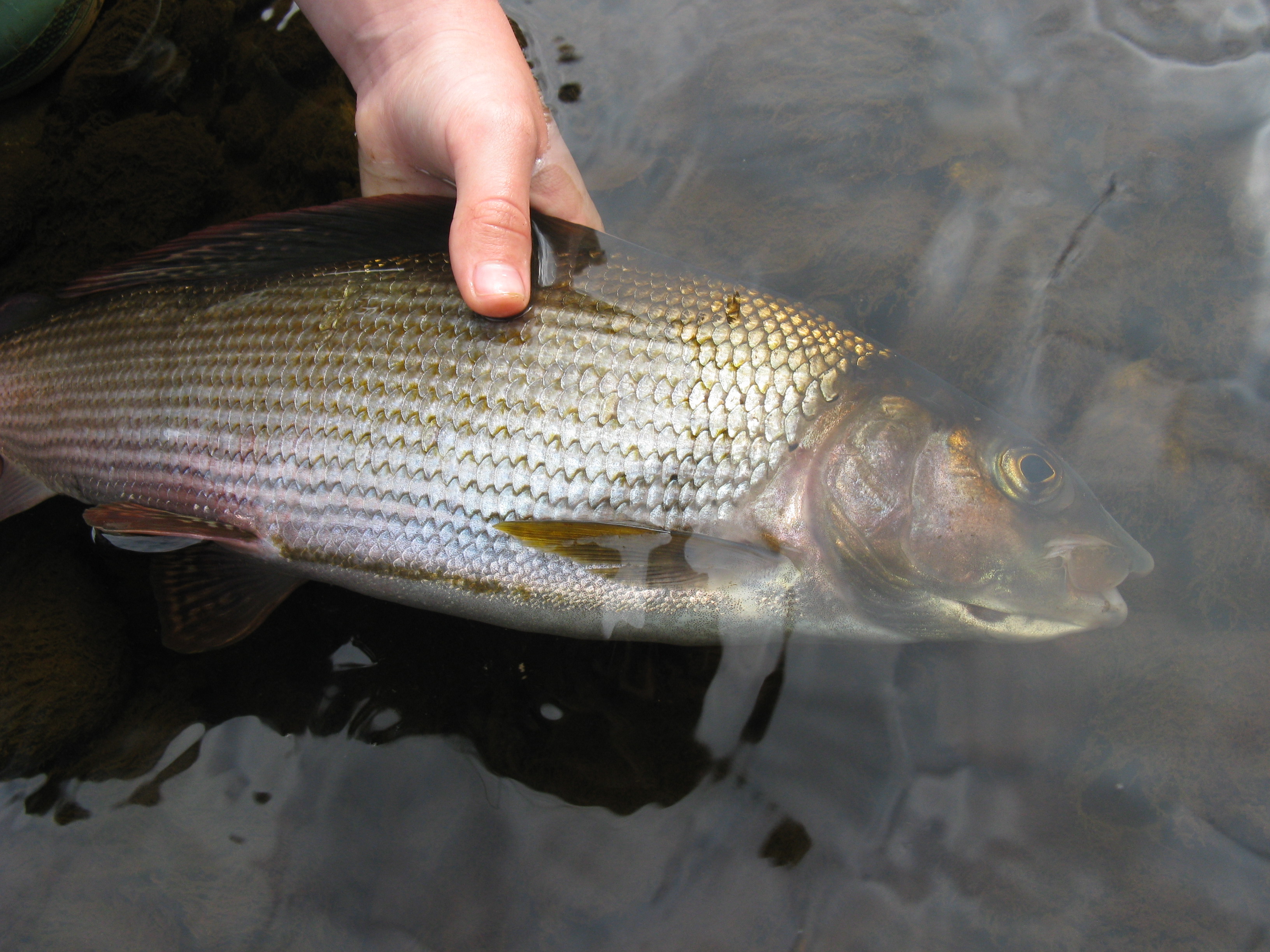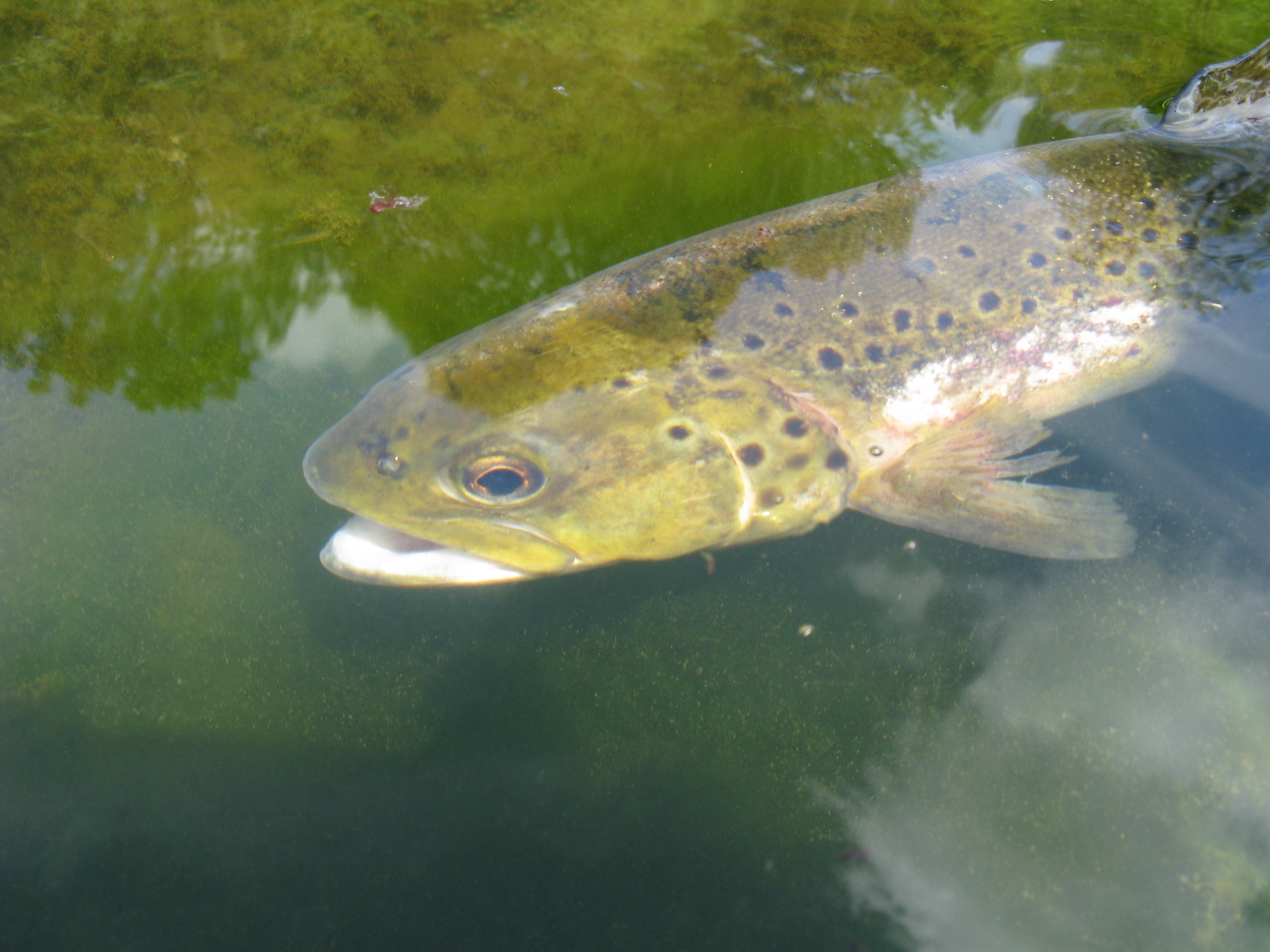Although my original angling site held many stories from the river bank - I shall herein just leave the reader with a few little tales to dwell on, plus a few of my own pictures.
FLOOD GRAYLING
It was the end of August and all we had been granted by the weather gods for several weeks was lots of rain and wind.Still, I thought, I'll have a trip to the river and see what's doing. when I got there the Hodder was up and very coloured. First impressions told me that the only people who would have any sport would be the salmon and sea- trouters with either a spinner or worm.As I had traveled with my son Kyle (who was with me to take photos of local butterflies for his Lepidoptera website) over thirty five miles from home I didn't feel like just running off when faced with this big flood. Not to be daunted, I put up my six foot midge rod and tied on a red tag.Surprisingly, before long I managed to rise a fish on the lip of a smooth fast run which head-butted my fly without getting a proper hold. Something told me to change the dressing quick so on went a trusty BWO and on the second cast the fish hit the fly hard. It turned out to be a nice silvery grayling of about twelve ounce which I gently returned to the pool unharmed.
My hopes and confidence changed dramatically with this fish and before long several more nice silver ladies graced my net.
The effective dry fly flood technique was to cast a short line up stream no more than about ten yards as most of the fish where very close into my bank, avoiding the main thrust of the spate. Takes were positive and not the sort of half-hearted pecks that can be so frustrating on low, clear conditions.
Later in the afternoon a salmon fisher came down to the water yet he had no success with his brightly-coloured Flying C lure.
I almost felt guilty at having such good sport on this flood with the tiny BWO when conditions seems to demand huge metal lures and bunches of worms for migratory species.
I ended up with six excellent Hodder grayling which is not a massive catch by any means but considering the adverse river condition was very pleasing. I also lost several fish and they all took the BWO dressing. Two, well over the pound mark, were kept for tea and they tasted better than trout.
The point of this little tale is that one should never give up hope and go home as there is always a chance of some dry fly sport - even in the most seemingly hopeless of conditions.
Dull day but still a few takers on the Hodder
And the
ramblings of a dry fly author!
Okay – not every day is the sort of day that you feel like writing in-depth stuff about fishing. However, at times a record of angling events is a worthy thing to undertake and if nothing else it serves as a good personal record for future reference.

A nice pool on the Hodder which was running peaty and fast on the day in question
More here:
http://www.amazon.co.uk/dp/1481250000/
And my other works...
http://patregan.jimdo.com/books-by-pat-regan/
A few hundred yards down stream and the current was deeper and slower, making rising fish easier to spot - but also easier to spook.
As per usual, a drop of water the night before a fishing trip is a welcome bonus
and will frequently get the fish moving to natural hatches.
Alas though on this particular day the river was a little higher than one would
like and more in keeping with salmon fishing. Sadly too, hatches were almost
none existent. This happens at times on all rivers; one day the place is
brimming with all manner of hatching duns and spinners then the next day the
place is almost lifeless.
Nonetheless, I managed to take several browns and a few bigger grayling all of which were carefully returned to grow larger.
A nice Hodder grayling which was quickly photographed then returned.
Holding the 'Silver Lady of the Steam' carefully in the current is very important so that recovery is complete after the fight. Never let them go back until you feel their strength return. I took this shot myself, which was quite an achievement at the time as my hands were wet and slippy.
Wild beauty: the Hodder's trout never seem to get to the larger proportions as their River Lune counterparts, yet they are still wonderful fish and time spent pursuing them with a dry fly is never ever wasted.
Now this little chap was again quickly photographed and released without harm, yet a second look at this snap suggested that it was a small sea-trout, a baby salmon or something in between. Nevertheless - they all eagerly take the tiny dry fly and that is what counts the most.
This is the type of general olive that can be very effective on the Hodder in early summer. Nothing too fancy but it does the business, time after time.
Successful flies on the day were general olive duns and black terrestrial dressings tied on light 18 - 20 hooks.
Top tip for the Hodder in early summer is to
incorporate a touch of orange into dun dressings.
Here below are a few of my pictures.
Blue Winged Olive
A grayling's dorsal fin
The Lune in spring time
A Twiss brownie of 2lb
A Yellow May Dun
Mixed bag off the River Lune on dry fly

Big Hodder graying going back to the stream to get even bigger

Wild brown trout caught on dry fly
Material on this site copyright of Pat Regan